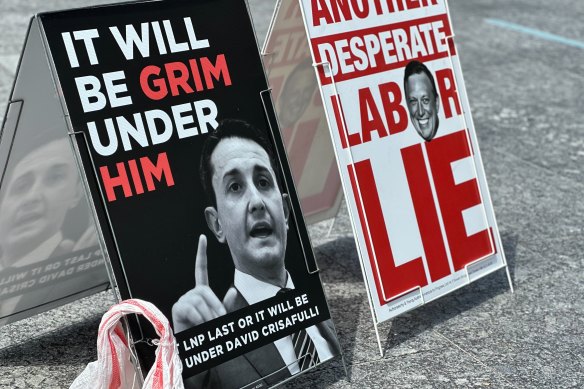How third-party players are spending big to influence Qld’s election
By Matt Dennien
When Queensland Labor changed election funding laws in 2020, experts and integrity advocates praised the move as some of the strongest reforms in the country to deal with political donations and campaign spending.
But not all were happy. While the caps effectively hobbled further Clive Palmer-style election spending sprees, the LNP labelled them “a full-frontal assault on the democratic process”.
The argument was, and is, that the laws benefit Labor due to the party’s heavy union support. But with talk of change again should the LNP take power, how does this argument stack up? Two charts give us a good idea – even if a third is months away.

Election ads from the Rail, Tram and Bus Union and Australian Institute of Progress – both registered third-parties in the campaign – outside the City Hall early voting booth this week. Credit: Cameron Atfield
1. Donations to political parties
While the laws were changed and campaign spending caps put in place before the 2020 election (not without some questions about the process), caps on political donations did not immediately apply.
At this election, the per-donor limit of $4000 to a registered political party, or $6000 to a candidate or a group endorsed by a party, applies to the money pouring in for election-related advertising or research over a period stretching back to July 2022.
(It is worth noting that parties have ways to bypass this via business program “memberships”.)
This is how the tally looks since council elections and state byelections in mid-March.
2. Donations to third parties
The political donation caps only apply to money flowing to political parties and candidates, not to third-party groups, which are required to register if they plan to sink more than $6000 into the fight.
This is how details in the graph below can occur, with groups related to the coal sector tipping some $2.2 million into three such third parties running various anti-Labor campaigns statewide or in key seats.
This link has given Labor ammunition in its attacks on the LNP, which it has accused of wanting to wind back the coal royalty tiers increased in 2022, which have netted the state billions.
LNP leader David Crisafulli has promised not to tinker with the tax (his campaign costings are expected on Thursday) in a first term of government, but has not ruled out changes beyond that, and has vowed to consult the sector (which he claims Labor did not).
3. Potential spending on both sides
OK, this one isn’t a chart, yet, but let me explain. The law changes put per-seat and statewide election spending caps on political parties, essentially limiting them to a maximum of $14.5 million.
The changes were heavily criticised by the LNP for the ability of the dozens of Labor-aligned or affiliated unions to register as a third party, allowing each to drop up to $1.03 million since April.
While donations are largely updated on the Electoral Commission of Queensland website in real time, party and third-party spending summaries have to be lodged within 15 weeks of polling day.
But we can get an idea of what these totals could be across the divide.
The $2.2 million in coal cash from QCoal’s Byerwen mine, and the opaque Coal Australia, has gone to groups attacking Labor for risking a mine closure, bad economic management and crime statistics.
One, the Australian Institute for Progress, counts several former state Liberal figures as directors. Former federal Ryan MP Julian Simmonds and a handful of other LNP figures are behind Australians for Prosperity.
While 16 of 38 registered third parties are unions able to tap into existing funds not captured by the donation scheme, they are tipped to spend significantly less than what they could on paper.
The state branch of the Australian Services Union, which goes by the name Together, is likely to be the biggest spender on the Labor side. “We’ll spend $1 million,” secretary Alex Scott told me.
Together kick-started its campaign even before the capped period began. The Electrical Trades Union, with a reheated “Not 4 Sale”, and the Queensland Nurses and Midwives’ Union are both running anti-privatisation campaigns.
And the peak Queensland Council of Unions might spend $500,000 itself, taking the movement’s total to about $2.5 million, general secretary Jacqueline King said.
And an asterisk
Several unions, but not all, also pay affiliation fees to Labor that sit outside the donation and election funding system, reportedly worth a tad over $1.5 million this year.
The government, held by Labor, can, and has, also funded ads promoting some of its recent measures.
University of Queensland professor Graeme Orr, whose expertise covers political and election laws, pointed out that all parties are also eligible for public funding of a portion of their campaigns.
He said political donations often favoured power in the form of incumbent parties, or those looking likely to form government, and ideology – the latter tending to be those “well-off”.
While he believed this election with its first full-use of the new laws “has been a foregone conclusion for so long it’s not a good test”, he did not think it seemed an “unfair” campaign.
But of course, the party with the deepest pockets does not necessarily win, either. Just ask Clive Palmer.
Start the day with a summary of the most important and interesting stories, analysis and insights. Sign up for our Morning Edition newsletter.